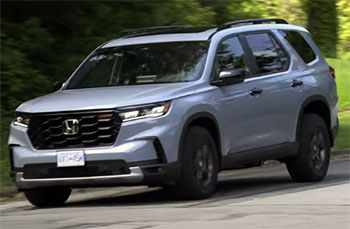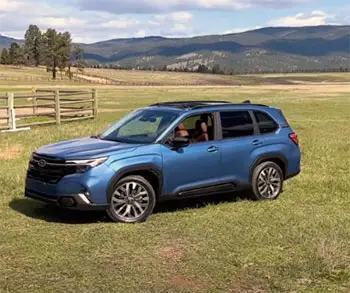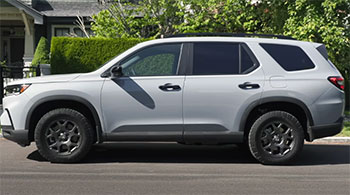As a busy parent juggling kids, groceries, and weekend adventures, I’ve spent hours researching the perfect SUV for my family. The 2025 Honda Pilot and Subaru Forester stand out as strong contenders, each offering reliability, comfort, and versatility.
In this article, I’ll share my firsthand experiences, comparing their performance, features, and practicality to help you decide which SUV fits your lifestyle. With a detailed pros and cons breakdown, a comparison table, and insights from my test drives, I aim to guide you toward the right choice for your family’s needs.
Comparison Table: Honda Pilot vs. Subaru Forester
| Feature | Honda Pilot | Subaru Forester |
|---|---|---|
| Starting MSRP | $41,650 | $31,995 |
| Seating Capacity | 7 or 8 | 5 |
| Engine | 3.5L V6 (285 hp, 262 lb-ft) | 2.5L Flat-4 (180 hp, 176 lb-ft) |
| Fuel Economy (City/Hwy) | 19/27 MPG | 26/33 MPG |
| Cargo Space (Behind 2nd Row) | 18.6 cu. ft. (87.0 cu. ft. max) | 29.6 cu. ft. (74.4 cu. ft. max) |
| Ground Clearance | 7.3 in. (TrailSport: 8.3 in.) | 8.7 in. (Wilderness: 9.2 in.) |
| AWD Availability | Optional | Standard |
| Infotainment Screen | 7.0-in. or 9.0-in. touchscreen | 6.5-in. or 11.4-in. touchscreen |
| Safety Rating (NHTSA) | 5 stars | 5 stars |
| Warranty | 3 yr/36,000 mi (5 yr/60,000 mi powertrain) | 3 yr/36,000 mi (5 yr/60,000 mi powertrain) |
My Experience With the Honda Pilot

Sliding into the 2025 Honda Pilot felt like stepping into a family command center.
This three-row midsize SUV is built for big crews, offering seating for seven or eight depending on the configuration.
I tested the TrailSport trim, which adds rugged styling and slightly higher ground clearance, but even the base model feels solid and refined.
The spacious cabin, with its clean lines and high-quality materials, immediately impressed me.
The 9-inch touchscreen on higher trims was intuitive, and the storage compartments were a lifesaver for stashing snacks and kids’ toys.
The Pilot’s 3.5-liter V6 engine, delivering 285 horsepower, made highway merges a breeze.
Its 10-speed automatic transmission shifted smoothly, and the ride soaked up road imperfections well, though I noticed some body lean in corners due to its size. On a family road trip, the third row accommodated adults for short trips, and folding the seats revealed a massive cargo area.
However, the 19/27 MPG fuel economy was a letdown, and the optional all-wheel drive (AWD) felt like an oversight for an SUV at this price. The Pilot is a dependable, family-friendly choice with premium touches, but its cost and fuel thirst gave me pause.
Pros of the Honda Pilot
- Powerful Engine: The 3.5-liter V6 pumps out 285 horsepower, offering confident acceleration for highway passing or towing up to 5,000 pounds with AWD.
- Spacious Interior: Seating for up to eight with generous legroom across three rows makes it ideal for large families or carpools.
- Ample Cargo Space: With 18.6 cubic feet behind the third row and 87.0 cubic feet max, it handles everything from groceries to camping gear.
- Refined Ride Quality: The suspension smooths out bumps, ensuring comfort on long drives or daily commutes.
- Advanced Safety Features: The Honda Sensing suite, including adaptive cruise control and blind-spot monitoring, is standard and feels polished.
- Premium Interior Design: The cabin’s soft-touch materials, honeycomb-patterned dash, and intuitive layout feel upscale.
- Versatile Configurations: Options like captain’s chairs and the TrailSport trim cater to luxury or light off-road needs.
- High Reliability: A J.D. Power score of 84/100 and owner reports of 200,000+ miles highlight its durability.
The Pilot’s versatility won me over on a camping trip. With a full load of passengers and gear, the V6 engine never struggled, even on steep hills. The blind-spot monitoring saved me in a busy parking lot, and the spacious interior kept everyone comfortable. The storage solutions, like the deep center console, were perfect for family chaos. If you need a do-it-all SUV for carpooling, road trips, or hauling, the Pilot delivers with confidence and a touch of class.
Read More: My Thoughts On Ford Escape Vs. Mazda CX-5
Cons of the Honda Pilot
- Higher Price Point: Starting at $41,650, it’s pricier than the Forester, potentially stretching budgets for some families.
- Lower Fuel Economy: At 19/27 MPG, it’s less efficient, leading to higher fuel costs compared to the Forester.
- Optional AWD: AWD isn’t standard, which feels like a miss for an SUV in this class, especially in snowy regions.
- Limited Off-Road Capability: The TrailSport’s 8.3-inch ground clearance is decent but not built for serious trails.
- Bulky Handling: Its size makes it less agile in tight spaces, with noticeable body lean in corners.
- Cramped Third Row: The third row is better for kids than adults on longer drives, limiting its versatility.
- Infotainment Lag: The base 7-inch touchscreen feels dated and sluggish; the 9-inch upgrade is better but not perfect.
- Higher Depreciation: Losing 43.6% of its value over five years, it trails the Forester’s 34.5% depreciation rate.
The Pilot’s price tag hit hard when I compared it to the Forester’s affordability. Frequent fuel stops on long drives were a drag, and parking in tight lots felt like a workout. The third row wasn’t ideal for my taller relatives, and the lack of standard AWD disappointed me for an SUV in this range. If budget or off-road capability is your focus, the Pilot might not fully satisfy.
My Experience With the Subaru Forester

The 2025 Subaru Forester feels like a rugged, budget-friendly companion.
This compact SUV seats five and maximizes interior space with its boxy design.
I drove the Wilderness trim, which boasts 9.2 inches of ground clearance and all-terrain tires, perfect for off-road adventures.
Standard AWD gave me confidence on slick roads during a rainy test drive, and the 26/33 MPG fuel economy was a welcome relief at the pump.
The 2.5-liter flat-four engine, with 180 horsepower, felt adequate but underpowered for quick highway merges.
The interior is functional, with a redesigned 11.4-inch touchscreen on higher trims that’s easy to use, though some hard plastics and a dated vibe detract from its appeal.
On a muddy trail, the Forester Wilderness impressed, handling rough terrain with ease. The cargo area, offering 29.6 cubic feet behind the rear seats, swallowed my camping gear effortlessly. For budget-conscious adventurers, the Forester is a gem, but it lacks the Pilot’s power and polish.
Pros of the Subaru Forester
- Standard AWD: Symmetrical AWD across all trims ensures grip in snow, rain, or light off-roading.
- Excellent Fuel Economy: 26/33 MPG saves money compared to the Pilot’s thirstier V6.
- Off-Road Capability: The Wilderness trim’s 9.2-inch ground clearance and all-terrain tires tackle trails with ease.
- Affordable Price: Starting at $31,995, it’s nearly $10,000 less than the Pilot, appealing to budget buyers.
- Spacious Cargo Area: With 29.6 cubic feet behind the rear seats and 74.4 cubic feet max, it’s great for gear-heavy trips.
- Strong Safety Ratings: A 5-star NHTSA rating and EyeSight suite (adaptive cruise, lane-keep assist) ensure safety.
- Better Resale Value: Retains 65.5% of its value after five years, outperforming the Pilot’s 56.4%.
- User-Friendly Infotainment: The 11.4-inch touchscreen is intuitive, with physical controls for quick adjustments.
The Forester’s affordability and capability shone on a snowy day, where its AWD and X-Mode made icy roads feel manageable. Fuel savings were noticeable, and the Wilderness trim handled a dirt trail like a pro. The cargo space fit my hiking gear perfectly, and the EyeSight safety features worked well, though less refined than the Pilot’s. For practicality and adventure on a budget, the Forester is a winner.
Cons of the Subaru Forester
- Underpowered Engine: The 180-horsepower engine feels sluggish for highway passing or merging.
- Dated Interior Design: Hard plastics and a functional but uninspired cabin feel less premium than the Pilot.
- Smaller Passenger Capacity: Seats only five, limiting its appeal for larger families.
- Noisy Cabin: Engine and wind noise at highway speeds can be intrusive, reducing comfort.
- No Third Row: Unlike the Pilot, it lacks a third-row option, restricting versatility.
- Slower Infotainment: The 11.4-inch touchscreen lags at times, and the base 6.5-inch screen feels outdated.
- Stiffer Ride: The suspension, tuned for off-road use, feels bumpy on pavement compared to the Pilot.
- Lower Towing Capacity: Maxes out at 3,000 pounds, versus the Pilot’s 5,000 pounds with AWD.
The Forester’s engine struggled on highways, and the cabin noise was noticeable on long drives. The lack of a third row limited its family appeal, and the interior’s plasticky feel didn’t match the Pilot’s refinement. If you need power, a quieter ride, or more seats, the Forester falls short.
Test Drive Tales

The Honda Pilot felt like a trusty family hauler during a weekend tournament.
Loaded with kids, gear, and snacks, it powered through highway traffic with ease.
The V6 engine handled hills without breaking a sweat, and the cabin stayed quiet enough for naps.
The 9-inch touchscreen kept my son entertained, but parking in a crowded lot was tricky, and fuel stops stung.
The TrailSport trim tackled a gravel road to a campsite, but it wasn’t built for rugged trails.
The Subaru Forester, especially the Wilderness trim, was a blast on a muddy trail.
Its AWD and high ground clearance navigated ruts effortlessly, and the fuel economy saved me money. The boxy design offered great visibility, but the engine felt weak merging onto highways, and the cabin’s hard plastics cheapened the experience. The cargo space handled my camping gear well, but I missed the Pilot’s extra seating for group outings.
Performance and Handling
The Pilot’s 3.5-liter V6 engine, with 285 horsepower and 262 pound-feet of torque, pairs with a 10-speed automatic for smooth, confident performance. It tows up to 5,000 pounds with AWD and handles highway cruising with ease. The ride is plush, though its size leads to body lean in corners. The 7.3-inch ground clearance (8.3 inches on TrailSport) limits off-road use to light trails.
The Forester’s 2.5-liter flat-four, with 180 horsepower and 176 pound-feet of torque, uses a CVT that feels adequate but sluggish. It takes 9.2 seconds to hit 60 mph, lagging behind the Pilot’s 6.2 seconds. The standard AWD and 9.2-inch ground clearance (Wilderness) make it a trail star, but the stiffer suspension feels bumpy on pavement.
Interior Comfort and Technology
The Pilot’s interior feels premium, with soft-touch surfaces, a sleek honeycomb dash, and supportive seats. The second row is spacious, but the third row is tight for adults. The 9-inch touchscreen supports wireless Apple CarPlay and Android Auto, and the deep center console is a family-friendly touch. The base 7-inch screen, however, feels dated.
The Forester’s boxy design maximizes headroom and visibility, but hard plastics and a utilitarian layout feel less upscale. The 11.4-inch touchscreen is user-friendly, though it lags occasionally, and the base 6.5-inch screen is underwhelming. Cargo space is generous, but the lack of a third row limits its family appeal.
Safety and Reliability
Both SUVs earn 5-star NHTSA ratings. The Pilot’s Honda Sensing suite, with adaptive cruise control and blind-spot monitoring, feels polished across all trims. The Forester’s EyeSight suite is solid but can be overly sensitive, and blind-spot monitoring isn’t standard on base models. The Pilot’s eight airbags edge out the Forester’s seven.
The Pilot scores 84/100 for reliability from J.D. Power, slightly ahead of the Forester’s 83/100. Owners report the Pilot lasting over 200,000 miles, though some older models had transmission issues. The Forester is durable but has had oil consumption problems in past models. The Forester’s better resale value (65.5% vs. 56.4%) is a long-term advantage.
Off-Road and All-Weather Capability
The Forester Wilderness, with 9.2 inches of ground clearance and X-Mode AWD, excels off-road, handling muddy trails with ease. Its hill-descent control and all-terrain tires add confidence. The Pilot’s TrailSport, with 8.3 inches of clearance, is fine for gravel but not rugged trails. The Forester’s standard AWD outperforms the Pilot’s optional system in snow or rain.
Cost and Value
The Pilot’s $41,650 starting price is steep compared to the Forester’s $31,995. Fully loaded, the Pilot hits $63,000, while the Forester tops out at $42,595. The Forester’s 26/33 MPG saves about $500 annually over the Pilot’s 19/27 MPG (assuming 15,000 miles). The Forester’s 65.5% resale value beats the Pilot’s 56.4%. However, the Pilot’s extra seating and premium features justify its cost for larger families.
Family-Friendly Features
The Pilot’s three-row seating and captain’s chair option make it a carpool king. Its storage solutions, like the underfloor cargo bin, kept my family organized. The Forester’s two-row layout limits its capacity, but its upright design and large windows make it easy to monitor kids. Both offer child-seat LATCH systems, but the Pilot’s extra anchors are a plus for bigger families.
Driving Dynamics in Different Conditions
In city driving, the Pilot’s size made parking a chore, but its smooth ride and powerful engine were great for commuting. The Forester’s compact size and visibility made it a breeze in traffic, though its engine felt strained. On highways, the Pilot’s quiet cabin and power shone, while the Forester’s noise and sluggishness were noticeable. Off-road, the Forester’s AWD and clearance dominated, while the Pilot was better suited for paved adventures.
Technology for Modern Families
The Pilot’s 9-inch touchscreen, wireless charging, and multiple USB ports kept my family connected. The available rear-seat entertainment system was a hit with my kids. The Forester’s 11.4-inch touchscreen was easy to use, but the lack of wireless charging on lower trims and slower response times were drawbacks. Both SUVs offer robust safety tech, but the Pilot’s system feels more refined.
Long-Term Ownership Considerations
The Pilot’s reliability and spaciousness make it a long-term family companion, though its depreciation and fuel costs add up. The Forester’s lower price, better fuel economy, and resale value make it a smarter financial choice, but its smaller size and less powerful engine may limit its appeal as families grow. Both are built to last, but the Pilot’s premium features come at a premium price.
Read More: My Thoughts On BMW X7 Vs. Cadillac Escalade
Frequently Asked Questions (FAQ)
It depends on your needs. Honda’s Pilot offers power and seating for larger families, while Subaru’s Forester excels in affordability and off-road capability. Choose based on family size and budget.
Its high price, lower fuel economy, optional AWD, limited off-road ability, bulky handling, cramped third row, and higher depreciation are key drawbacks.
Yes, with a J.D. Power score of 84/100, it often exceeds 200,000 miles with proper maintenance, though some models have had transmission issues.
The Pilot (84/100) is slightly more reliable than the Ascent (80/100), with fewer reported issues, but both are dependable.
Conclusion: For Your Next SUV
The 2025 Honda Pilot and Subaru Forester cater to different needs. If you have a large family and value power, space, and premium features, the Pilot’s V6, three-row seating, and refined interior are worth the higher cost, despite its fuel economy and optional AWD. For budget-conscious buyers or outdoor enthusiasts, the Forester’s standard AWD, fuel efficiency, and off-road prowess make it a steal, though it lacks the Pilot’s polish and seating capacity. For my family, the Pilot’s versatility won, but your choice depends on whether you prioritize space, luxury, or affordability.

